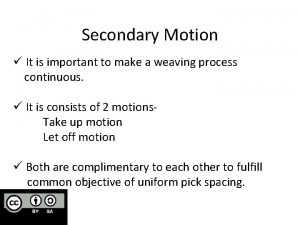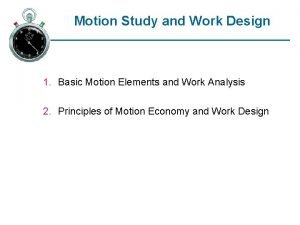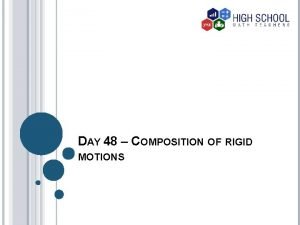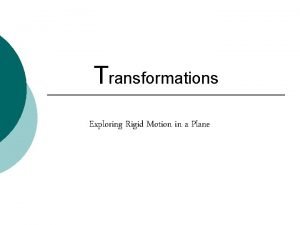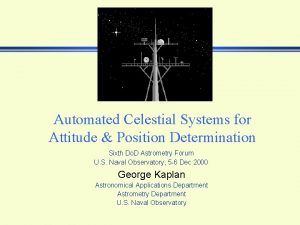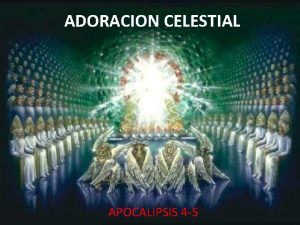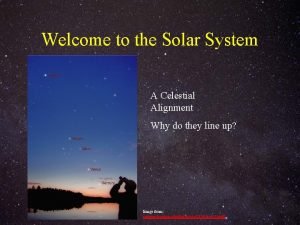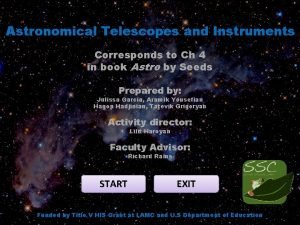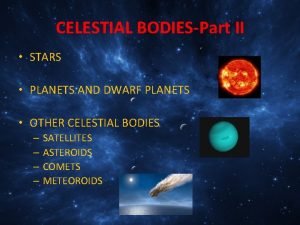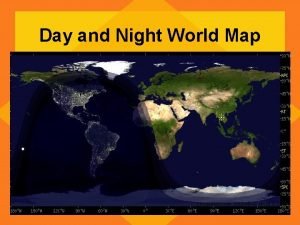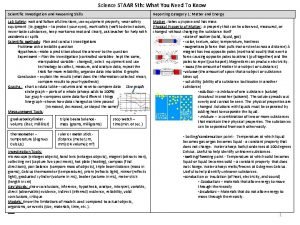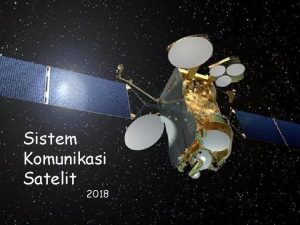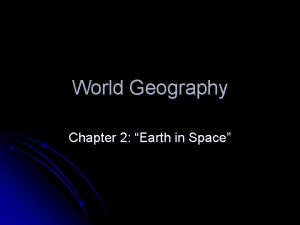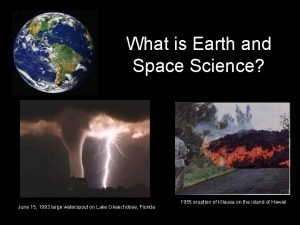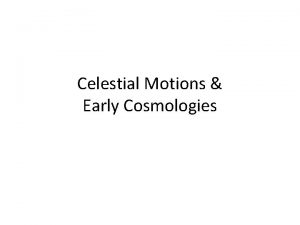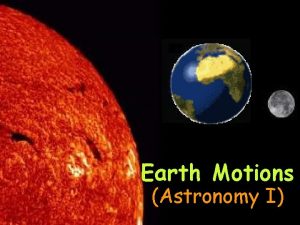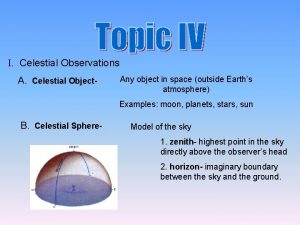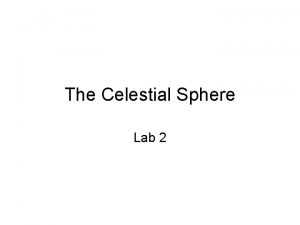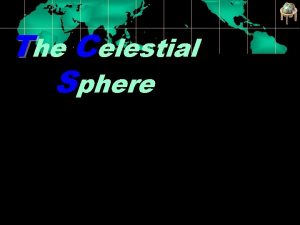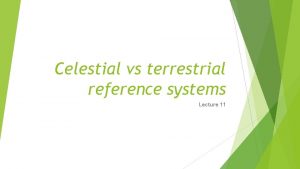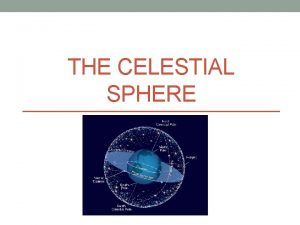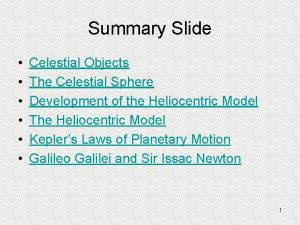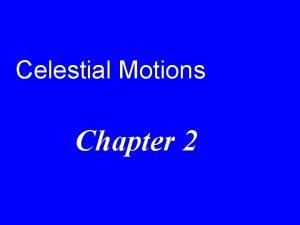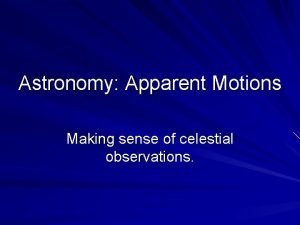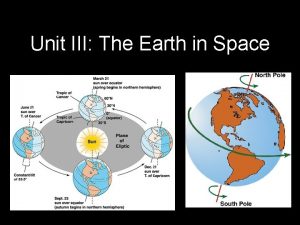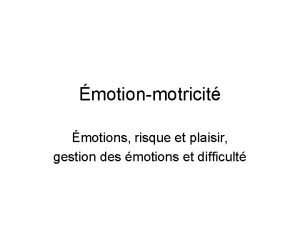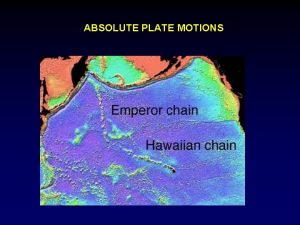The Earth in Space Celestial Motions The Night




































































































- Slides: 100

The Earth in Space • Celestial Motions • The Night Sky • Seasons • Moon Phases • Eclipses 12/1/2020 1

Motions of Celestial Objects • The celestial sphere describes the dome of sky that you can observe • Celestial objects are observable objects like stars, planets, etc. 12/1/2020 2

Imagine all the stars moved down onto a big glass sphere around the Earth. Stars Celestial equator 12/1/2020 3

Stars celestial sphere is stationary Earth Rotates Counterclockwise 12/1/2020 4

Motions of Celestial Objects • The celestial objects that arc across the sky appear to rise in the East and set in the West – Except for celestial objects close to Polaris which appear to revolve around Polaris – Also except for the planets which appear to “wander”, sometimes moving East to West, sometimes moving West to East, and sometimes appearing to stand still 12/1/2020 5

Motions of Celestial Objects • All celestial objects, including our moon and sun, appear to move 15 angular degrees per hour 12/1/2020 6

What are the APPARENT MOTIONS of Celestial Objects • An apparent motion is a motion an object appears to make • An apparent motion can be real or an illusion • For example, the stars appear to move across the sky from east to west • However, the apparent motion is caused by Earth’s rotation 12/1/2020 7

Stars in constellations are often very far from one another but we see them in the same direction in the sky. Big Dipper 12/1/2020 8

Pointer Stars point to Polaris 12/1/2020 9

• Looking upward we see the stars fixed on the celestial sphere • Earth’s eastward rotation makes the stars between the equator and north celestial pole appear to move westward • Rise in the east and set in the west. • Timed photography showing stars rising in the east 12/1/2020 10

Stars appear to be moving from east to west. Stars rising in the east. 12/1/2020 11

Stars appear to be moving from east to west. Rise in the east and set in the west. 12/1/2020 12

Northern part of the sky around Polaris CCW 12/1/2020 Moving west to east 13

Earth’s counter clockwise rotation makes the stars appear to rotate counter clockwise around the north celestial pole (Polaris). 12/1/2020 14

Star trails about Polaris 12/1/2020 15

12/1/2020 16

Why 15° per hour? • All objects appear to circle around the Earth in one day • There are 24 hours in one day – A day is the length of time it take a planet to rotate about it’s axis • There are 360 degrees in a circle – Like a round planet • 360° divided by 24 hours = 15° per hour 12/1/2020 17

Motions of Earth • The Earth rotates about its axis once every 24 hours – Called a DAY – Daily motion known as rotation • The Earth revolves around the sun once every 365 days – Called a YEAR – Annual motion known as revolution 12/1/2020 18

1. Evidence of Earth’s Rotation • 1851, Foucault’s pendulum will appear to change in a predictable way. • Why is this evidence? There is no force acting on the pendulum to make its plane of oscillation rotate or go around its own axis • It would continue to swing in the original path if Earth did not rotate. 12/1/2020 19

No force that makes pendulum rotate – must be earth that is rotating!!! 12/1/2020 20

12/1/2020 21

2. Evidence for Rotation • Coriolis Effect – the tendency of objects moving over the earth (air, water, planes, projectiles) to be deflected (curve away) from a straight line path. The French scientist, Gaspard Coriolis, first explained the deflection of objects moving over the surface due to Earth’s rotation • The deflection is to the right in the Northern Hemisphere and to the left in the Southern Hemisphere. • This deflection occurs because Earth’s surface is rotating with respect to the objects. 12/1/2020 22

12/1/2020 23

12/1/2020 24

12/1/2020 25

Evidence of Revolution Parallax Shift • Because of Earth’s revolution about the sun, near stars seem to shift their position against the farther stars (closer star – greater the shift) • If you observe the same star while earth is at 2 different points during its orbit around the sun, the star’s position relative to the more distant background stars will appear to change. 12/1/2020 26

12/1/2020 27

12/1/2020 28

Different constellations at different times of the year 12/1/2020 29

Tilt of the axis always stays the same 12/1/2020 30

12/1/2020 31

Seasons on Earth • Our sun appears to take different arcs through the celestial sphere during different times of the year 12/1/2020 32

12/1/2020 33

12/1/2020 34

90° Perpendicular Rays of the Sun aka the ZENITH POSITION • The noon perpendicular rays of the sun travel southward from the Tropic of Cancer (23. 5° N) on June 21 passing the Equator on September 21 and going to the Tropic of Capricorn (23. 5° S) where it turns around and starts going back up passing the Equator on March 21 and arriving at the Tropic of Cancer again on June 21. 12/1/2020 35

Zenith Position of the Sun • Because of the earth’s spherical shape, on any particular date, there is just 1 place where insolation (incoming solar radiation) is at an angle of 90°. All other places are less than 90°. • Does the 90° ever reach the United States? • An observer in New York State will never see the Sun directly overhead. 12/1/2020 36

Seasons on Earth Orbital plane 12/1/2020 Earth’s tilt 37

12/1/2020 38

Earth’s Revolution around the Sun – the tilt of Earth’s axis does not change producing a cyclical change of seasons 12/1/2020 39

12/1/2020 40

Seasons on Earth • At the Equinox the sun’s rays are directly over the Equator – Vernal Equinox: March 21 – Autumnal Equinox: September 23 12/1/2020 41

Seasons on Earth • Notice that during the equinox the sun rises and sets due east and west of every location on Earth • Every location on Earth experiences equal length of day and night 12/1/2020 42

Seasons on Earth • During the summer solstice the Earth’s tilt causes the sun’s rays to shine mostly in the northern hemisphere 12/1/2020 43

Seasons on Earth • Notice that in the summer the sun rises and sets to the north of due east and due west 12/1/2020 44

Seasons on Earth • During the winter solstice the sun’s rays shine mostly in the southern hemisphere 12/1/2020 45

Seasons on Earth (cont. ) • And during the winter the sun rises and sets to the south of due east and west 12/1/2020 46

Latitude and the Angle of the Sun Only within the tropics can the sun be found directly overhead (at the zenith) • Tropics are defined as an area between 23. 5° north and 23. 5° south of the Equator – Tropic of Cancer is the northern limit – Tropic of Capricorn is Southern limit 12/1/2020 47

The apparent rising and setting of the sun is due to rotation Changes in the altitude of the path and horizon position of sunrise and sunset are due to revolution Season Sunrise Sunset Summer North of east west Equinox Fall/Spring Winter Due east Due West South of east South of west 12/1/2020 48

12/1/2020 49

12/1/2020 50

12/1/2020 51

Models of the Night Sky • The geocentric model – Believed for thousands of years – Earth is the center of the universe • Geo means Earth 12/1/2020 52

Models of the Night Sky • The heliocentric model – proposed by Copernicus – sun in the center • Helio for sun 12/1/2020 53

Daily Movement of the Moon • Each day the Moon rises in the east and sets in the west as a result of the Earth's rotation. • It moves about 13° eastwards against the background of stars as a consequence of its revolution around the Earth. 12/1/2020 54

Moon’s Rotation = Moon Revolution Ø rotation period = 27. 3 days Ø revolution period = 27. 3 days Ø Moon shows the same “face” to the Earth Ø Velocity: 360°/27. 3 days = 13° per day 12/1/2020 55

12/1/2020 56

12/1/2020 57

Moon Phases Ø Half of the moon is always receiving light from the sun. Ø The “lit” portion that is visible to earth varies as the moon REVOLVES around earth. THIS CAUSES THE PHASES OF THE MOON. Ø Visible portion of moon growing = waxing Ø Visible portion of moon shrinking = waning 12/1/2020 58

Phases of the Moon • Moon phases depend upon the relative positions of the Earth, moon and sun 12/1/2020 59

Lunar Phases 12/1/2020 60

3 2 1 1 New moon 2 First crescent 12/1/2020 3 First quarter First gibbous Full moon Old (last) gibbous Last quarter Last crescent 61

Phases of the Moon • Full moon – When one half of the moon is seen from Earth – The entire side we see is lit by the sun’s rays 12/1/2020 62

Phases of the Moon • Quarter moon phase – When one quarter of the moon is seen from Earth 12/1/2020 63

How much of the moon we see depends on where the moon is in its orbit: Appearance: 12/1/2020 64

Appearance: 12/1/2020 65

Appearance: 12/1/2020 66

What we observe from earth 12/1/2020 67

Phases of the Moon Where in the sky is the full moon when the sun is setting? 12/1/2020 68

Phases of the Moon • The full moon must be rising when the sun is setting – The Earth must be between the sun and the moon in order for us to see the entire lit side of the moon Not to scale 12/1/2020 sun Earth moon 69

Cycle of Lunar Phases Ø Takes 29. 53 days Ø This is because when moon gets back to its original position in 27. 3 days, the earth has moved 1°/day or about 27°. Ø The moon moving at l 3°/day takes about 2 days to catch up with Earth and align with it and the sun in a new moon phase. 12/1/2020 70

12/1/2020 71

12/1/2020 72

Daily Cycle of Tides Ø Driven by the gravitational pull of the moon and Sun Ø Affected by nearness of the moon more than the size of the Sun Ø As earth rotates, the tides move around the Earth alternating between high and low tides approximately every 6 hours. 12/1/2020 73

12/1/2020 74

12/1/2020 75

Spring Tides – Neap Tides Ø Tidal range: Difference in height between high tide and low tide Ø Spring Tides: new and full moon phase – greatest range Ø Neap Tides: 1 st and 3 rd Quarter phases – smallest range 12/1/2020 76

12/1/2020 77

12/1/2020 78

Eclipses of the moon and sun 12/1/2020 79

Lunar Eclipse 12/1/2020 80

12/1/2020 81

Eclipsed moon can look red 12/1/2020 Some red light gets through Earth’s atmosphere. “Blue scatters better”. 82

Time lapse photo of a partial lunar eclipse: 12/1/2020 83

Solar Eclipse: moon shadow on Earth 12/1/2020 84

12/1/2020 85

Animated solar eclipse Moon’s shadow moves 12/1/2020 86

Solar eclipse takes a couple hours but totality is ~4 min 12/1/2020 87

Eclipses of the Moon and Sun • This is an image of the 1994 solar eclipse • The moon gets between the Earth and the sun 12/1/2020 88

Solar Eclipses Don’t look directly at sun During a solar eclipse: What is the moon’s phase? Who can see the eclipse? What would someone on the moon see? 12/1/2020 89

Why there is not an eclipse every month: Moon’s orbit is tilted 12/1/2020 90

Eclipses of the Moon and Sun • Why doesn’t a solar eclipse happen every time the moon gets on the sun side of the Earth? • Moon’s orbital plane is not the same as the Earth’s orbital plane 12/1/2020 91

12/1/2020 92

annular eclipse 12/1/2020 93

Annular Eclipse = Moon too far away to eclipse whole sun 12/1/2020 94

Annular Solar eclipse 10 days ago: Sept 22 (also Oct. 3, 2005) • What is the phase of the moon today? (the clue is above…. ) 12/1/2020 95

• Annular solar eclipse Nov 23, 2003 in antarctica Why are eclipses only SOMETIMES annular? 12/1/2020 96

Pinhole ‘camera’ to view solar eclipse ‘sundrops’ seen through tree leaves 12/1/2020 97

Safe viewing 12/1/2020 98

Earthshine 12/1/2020 99

12/1/2020 100
 Pathfinder honors answers
Pathfinder honors answers Primary motions of weaving
Primary motions of weaving Therblig
Therblig Rigid motion
Rigid motion Song leading hand motions
Song leading hand motions Ocean motions
Ocean motions Model un motions
Model un motions Basic rigid motions
Basic rigid motions What is separation
What is separation Which transformations map the strip pattern onto itself
Which transformations map the strip pattern onto itself True motions
True motions Mitosis flip book pdf
Mitosis flip book pdf Alphafriends with motions
Alphafriends with motions Weisels
Weisels Silent night holy night all is calm all is bright
Silent night holy night all is calm all is bright Querido padre celestial te agradezco por
Querido padre celestial te agradezco por Automated celestial navigation system
Automated celestial navigation system Perpendicular distribution hair
Perpendicular distribution hair Sede perfeitos como perfeito é o vosso pai celestial
Sede perfeitos como perfeito é o vosso pai celestial La adoración celestial explicacion
La adoración celestial explicacion Belt of celestial alignment
Belt of celestial alignment Querido padre celestial te agradezco por
Querido padre celestial te agradezco por Te rogamos señor que derrames tu gracia en nuestras almas
Te rogamos señor que derrames tu gracia en nuestras almas Querido padre celestial
Querido padre celestial Hoy nace una clara estrella
Hoy nace una clara estrella Celestial bodies context clues
Celestial bodies context clues Sees the celestial
Sees the celestial Local hour angle
Local hour angle Padre celestial al entrar en mi lugar de trabajo
Padre celestial al entrar en mi lugar de trabajo Querido padre celestial te agradezco por
Querido padre celestial te agradezco por Padre celestial al entrar en mi lugar de trabajo
Padre celestial al entrar en mi lugar de trabajo Cantos de apocalipsis
Cantos de apocalipsis Celestial event
Celestial event Deus nosso pai celestial
Deus nosso pai celestial Biografia de tristan tzara
Biografia de tristan tzara Centered celestial object
Centered celestial object Celestial objects
Celestial objects Celestial nocchiero
Celestial nocchiero Celestial event
Celestial event Celestial dwarf
Celestial dwarf What causes day and night
What causes day and night World day night map
World day night map Nine times the space that measures day and night
Nine times the space that measures day and night 8th grade science staar review reporting category 4
8th grade science staar review reporting category 4 Pada komunikasi satelit, yang termasuk segmen bumi adalah
Pada komunikasi satelit, yang termasuk segmen bumi adalah This insulates our earth from the deep cold of space
This insulates our earth from the deep cold of space Earth's role as a body in space
Earth's role as a body in space Space art lesson
Space art lesson Chapter 2 the earth in space answers
Chapter 2 the earth in space answers Space in science meaning
Space in science meaning Cartesian space trajectory planning
Cartesian space trajectory planning Space junk the space age began
Space junk the space age began Camera space to world space
Camera space to world space Unscented trajectory chapter 5
Unscented trajectory chapter 5 Ndc to screen space
Ndc to screen space Hình ảnh bộ gõ cơ thể búng tay
Hình ảnh bộ gõ cơ thể búng tay Bổ thể
Bổ thể Tỉ lệ cơ thể trẻ em
Tỉ lệ cơ thể trẻ em Chó sói
Chó sói Chụp phim tư thế worms-breton
Chụp phim tư thế worms-breton Hát lên người ơi alleluia
Hát lên người ơi alleluia Môn thể thao bắt đầu bằng chữ f
Môn thể thao bắt đầu bằng chữ f Thế nào là hệ số cao nhất
Thế nào là hệ số cao nhất Các châu lục và đại dương trên thế giới
Các châu lục và đại dương trên thế giới Cong thức tính động năng
Cong thức tính động năng Trời xanh đây là của chúng ta thể thơ
Trời xanh đây là của chúng ta thể thơ Mật thư tọa độ 5x5
Mật thư tọa độ 5x5 Làm thế nào để 102-1=99
Làm thế nào để 102-1=99 độ dài liên kết
độ dài liên kết Các châu lục và đại dương trên thế giới
Các châu lục và đại dương trên thế giới Thể thơ truyền thống
Thể thơ truyền thống Quá trình desamine hóa có thể tạo ra
Quá trình desamine hóa có thể tạo ra Một số thể thơ truyền thống
Một số thể thơ truyền thống Cái miệng nó xinh thế
Cái miệng nó xinh thế Vẽ hình chiếu vuông góc của vật thể sau
Vẽ hình chiếu vuông góc của vật thể sau Biện pháp chống mỏi cơ
Biện pháp chống mỏi cơ đặc điểm cơ thể của người tối cổ
đặc điểm cơ thể của người tối cổ Thế nào là giọng cùng tên?
Thế nào là giọng cùng tên? Vẽ hình chiếu đứng bằng cạnh của vật thể
Vẽ hình chiếu đứng bằng cạnh của vật thể Tia chieu sa te
Tia chieu sa te Thẻ vin
Thẻ vin đại từ thay thế
đại từ thay thế điện thế nghỉ
điện thế nghỉ Tư thế ngồi viết
Tư thế ngồi viết Diễn thế sinh thái là
Diễn thế sinh thái là Dạng đột biến một nhiễm là
Dạng đột biến một nhiễm là Số.nguyên tố
Số.nguyên tố Tư thế ngồi viết
Tư thế ngồi viết Lời thề hippocrates
Lời thề hippocrates Thiếu nhi thế giới liên hoan
Thiếu nhi thế giới liên hoan ưu thế lai là gì
ưu thế lai là gì Hổ sinh sản vào mùa nào
Hổ sinh sản vào mùa nào Sự nuôi và dạy con của hổ
Sự nuôi và dạy con của hổ Hệ hô hấp
Hệ hô hấp Từ ngữ thể hiện lòng nhân hậu
Từ ngữ thể hiện lòng nhân hậu Thế nào là mạng điện lắp đặt kiểu nổi
Thế nào là mạng điện lắp đặt kiểu nổi Gabby and sydney bought some pens
Gabby and sydney bought some pens The night pirates activities ks1
The night pirates activities ks1 I had to finish my homework last night
I had to finish my homework last night What is stem night
What is stem night

